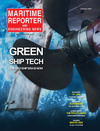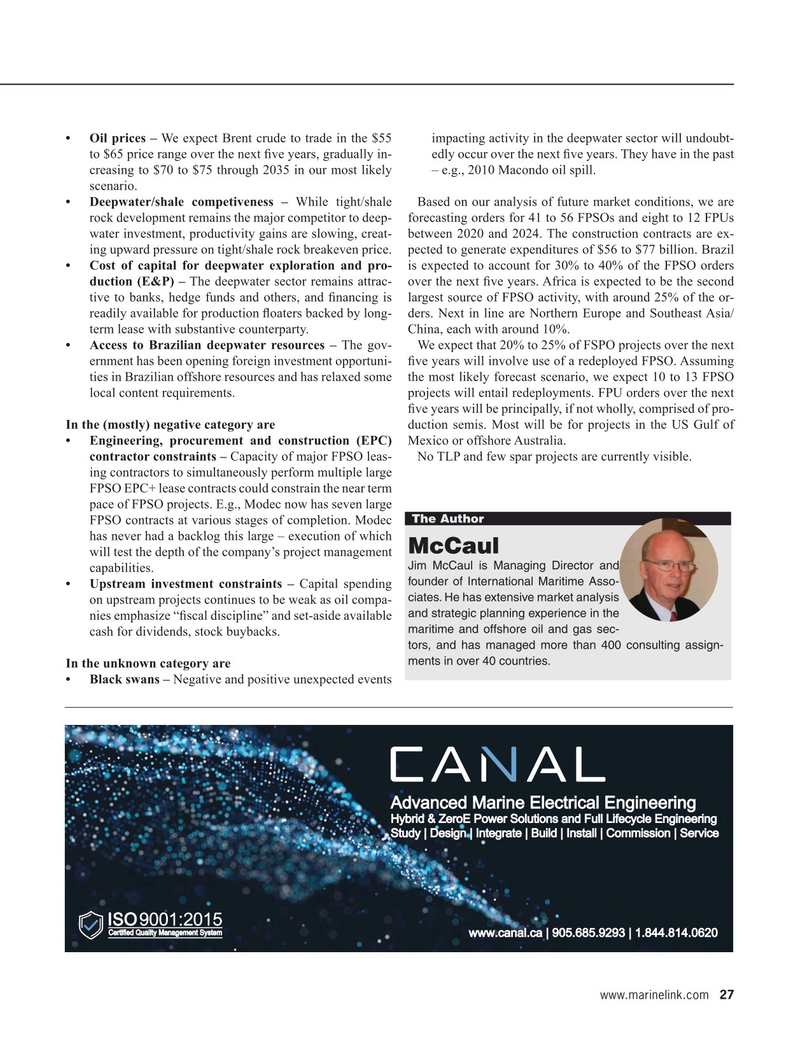
Page 27: of Maritime Reporter Magazine (February 2020)
Green Ship Technology
Read this page in Pdf, Flash or Html5 edition of February 2020 Maritime Reporter Magazine
• Oil prices – We expect Brent crude to trade in the $55 impacting activity in the deepwater sector will undoubt- to $65 price range over the next ? ve years, gradually in- edly occur over the next ? ve years. They have in the past creasing to $70 to $75 through 2035 in our most likely – e.g., 2010 Macondo oil spill.
scenario.
• Deepwater/shale competiveness – While tight/shale Based on our analysis of future market conditions, we are rock development remains the major competitor to deep- forecasting orders for 41 to 56 FPSOs and eight to 12 FPUs water investment, productivity gains are slowing, creat- between 2020 and 2024. The construction contracts are ex- ing upward pressure on tight/shale rock breakeven price. pected to generate expenditures of $56 to $77 billion. Brazil • Cost of capital for deepwater exploration and pro- is expected to account for 30% to 40% of the FPSO orders duction (E&P) – The deepwater sector remains attrac- over the next ? ve years. Africa is expected to be the second tive to banks, hedge funds and others, and ? nancing is largest source of FPSO activity, with around 25% of the or- readily available for production ? oaters backed by long- ders. Next in line are Northern Europe and Southeast Asia/ term lease with substantive counterparty. China, each with around 10%. • Access to Brazilian deepwater resources – The gov- We expect that 20% to 25% of FSPO projects over the next ernment has been opening foreign investment opportuni- ? ve years will involve use of a redeployed FPSO. Assuming ties in Brazilian offshore resources and has relaxed some the most likely forecast scenario, we expect 10 to 13 FPSO local content requirements. projects will entail redeployments. FPU orders over the next ? ve years will be principally, if not wholly, comprised of pro-
In the (mostly) negative category are duction semis. Most will be for projects in the US Gulf of • Engineering, procurement and construction (EPC) Mexico or offshore Australia. contractor constraints – Capacity of major FPSO leas- No TLP and few spar projects are currently visible. ing contractors to simultaneously perform multiple large
FPSO EPC+ lease contracts could constrain the near term pace of FPSO projects. E.g., Modec now has seven large
The Author
FPSO contracts at various stages of completion. Modec has never had a backlog this large – execution of which
McCaul will test the depth of the company’s project management
Jim McCaul is Managing Director and capabilities. founder of International Maritime Asso- • Upstream investment constraints – Capital spending ciates. He has extensive market analysis on upstream projects continues to be weak as oil compa- and strategic planning experience in the nies emphasize “? scal discipline” and set-aside available maritime and offshore oil and gas sec- cash for dividends, stock buybacks.
tors, and has managed more than 400 consulting assign- ments in over 40 countries.
In the unknown category are • Black swans – Negative and positive unexpected events www.marinelink.com 27
MR #2 (18-33).indd 27 2/5/2020 12:16:22 PM

 26
26

 28
28
